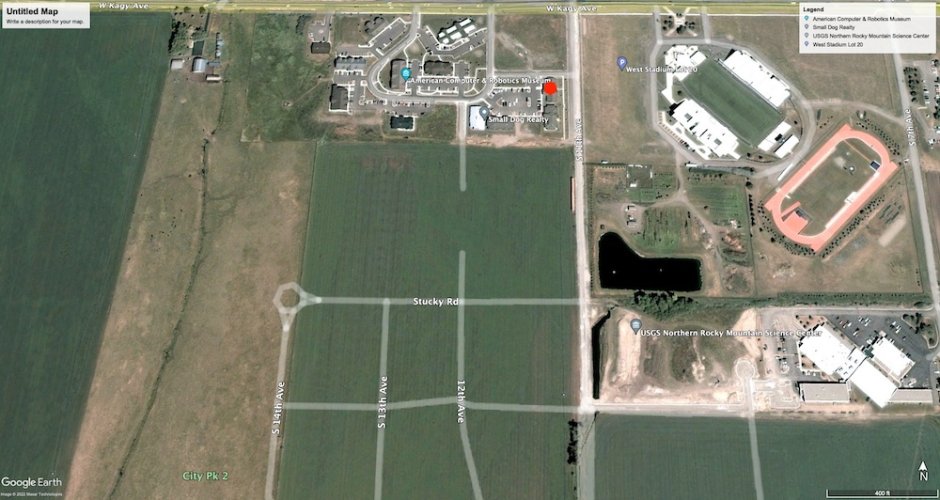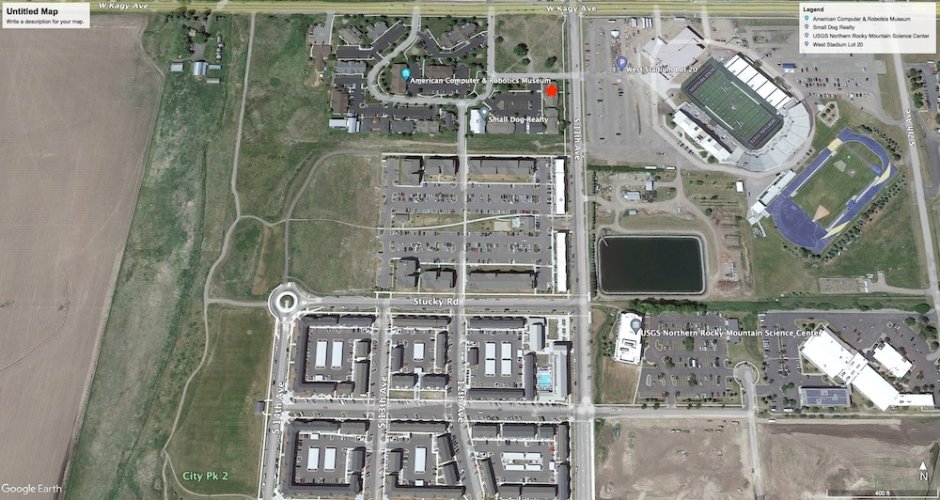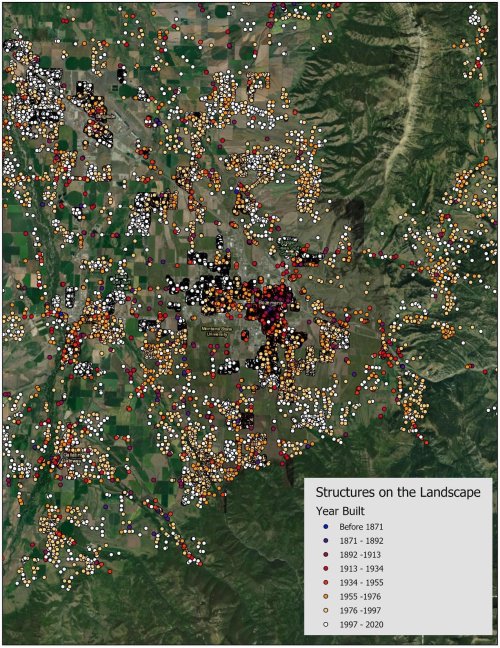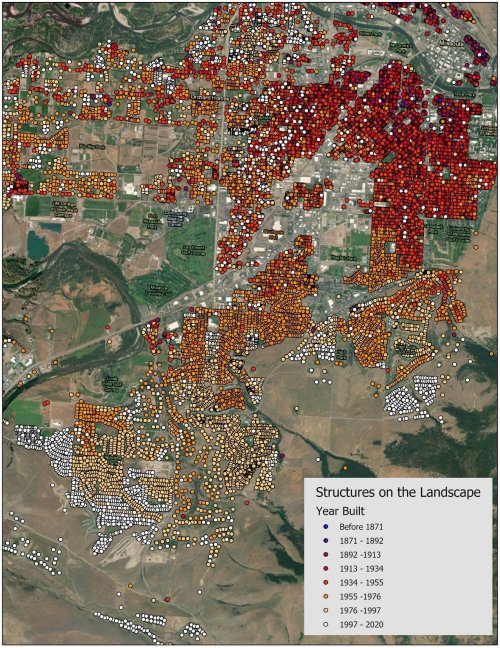Gerald Martin
Well-known member
- Joined
- Jul 3, 2009
- Messages
- 9,414
Where you stand determines the view.
Follow along with the video below to see how to install our site as a web app on your home screen.
Note: This feature may not be available in some browsers.
Where you stand determines the view.
Same with the little town I live near. Seems like the changes in the small towns are more visible. At least to me. I hate what has happened here. mtmuleyBozeman’s that good. Which is why people are flocking here. It’s certainly changed over the years. For better or worse, mostly worse.
Exponential population and monetary growth throughout the west Since this nation was new, the conventional wisdom has been to Go west and grow young with the country. Job availability used to be a limiting factor. 2 trends derailed that. First was and is retirement by boomers with double rooftop car carriers full of home equity and savings. Second, virtual jobs that free employees to live in paradise while working in their basement. Fuel that with online exposure of next best places and it becomes the latest, modern land rush, an American Dream for the new milennium. For more than a century western booms were made of homesteading, mineral and resource extraction, grazing on empty eternities, and fast access via rail, auto and air.
Now the magnet is location, location, location. Experience-hungry readers lap up endless rehashings of Top Ten adventure destinations, retirement havens, river towns, mountain villages, ski centers, hiking, biking and even dog friendly happily-ever-afters. And the latest rush is on, enhanced by warming winters in formerly inhospitable mountain valleys. Tight communities of families and neighbors sharing a place for generations, evolving a balance between independence and interdependence, are inundated by those people from those places with those values. Native Americans note the painful irony of mostly white people doing to each other what they did to the tribes.
In this accelerating world, you have to constantly look ahead. Will this perfect community stay sweet for 10 years, like the previous one? Maybe 7 or 5 years? More importantly, where will be the next best place? Meanwhile, what if the big lakes and small streams dry up, what if it only snows on the slopes for 2 months? What if the fish, the birds, the ungulates are squeezed out by squeezing more pickups, storage yards, ranchettes, business loops, megachurches?
What if we and our leaders recognized we've largely exhausted the empty, awesome spaces, just waiting for us to perfect them by our arrival? What if we started planning to stay put for a few generations, preserving and enhancing our special places? What if the value of living well and lightly on each lovely landscape became higher than the monetary value of invading, ruining and deserting our last besties?
But American Prairie wanting to own their piece of Montana is a pain in his hypocritical ass?Will you please run for governor before this guy does?
Most of what you said is the sane for most everybody's hometown that they like to some degree. Times are changing, too many people everywhere.Friend of mine moved from Bozeman, then to Big Timber, then to Billings. Always remember what he said when he left Bozeman, around 15 years ago, "It was like getting dumped by a girl that was way out of your league to start with."
Bozeman is fantastic. There's no town in the 100K population range like it in the west that I've seen, my opinion. To each their own. Rolling the clock back a decade or two - I'd like that. But that goes for most hunting statewide too. Too many people are here and continue to swarm, some good ones, some bad ones. Some of the best people I know moved here from places everybody complains about. Some of the worst people I know are total born and raised Montanans. There's no doubt prices are out of control and there is a pretty snobby element to Bozeman.
I find it funny that most people that complain about people moving here, also moved here from elsewhere and many, not so long ago.. And when I hear the complaints/mockery about Bozeman from others, it's always interesting to see where they live.


I am part of the problem, coming here for my first visit in 1989 and moving here in 1991. At that time, the Bozeman Daily Chronicle was filled with ads, "Take Over Payments." The economy sucked. If you were moving to Bozeman, or most anywhere in SW Montana at that time, people questioned your sanity. The mines in Butte/Anaconda had closed. Sawmills and logging were on the way out. Ag was in a tough spot. Undeterred, Mrs. Fin and I took a combined 40% pay cut to move here, thinking we landed some good jobs for that time. I was good with Bozeman being a place of net-population loss at that time, as I wasn't taking these pay cuts to get rich, rather for what Montana offered as a quality of life.
I travel to all the great outdoor locations as part of this gig. As mentioned above, those places are undergoing the same exact thing as Bozeman, with Bozeman maybe leading the way as far as real estate prices and the rapidity of change.
It didn't have to be like this, but we have elected leaders who have allowed it to happen. I'll try to explain.
Many of us spent a lot of time from 1998-2004 working on the "Bozeman Area Master Plan," a development road map that was meant to plan the development of Bozeman and the surrounding area over the next 50 years. The City and County Commissioners and a lot of the agricultural property owners deserved a lot of credit for putting together what I thought was a damn good Master Plan. A lot of people got involved and it was very heated at times.
But, like all plans, if you don't follow the plan, the results will be like what we see here. These two maps below show one little example of how a good plan can got to hell if not followed.
2005 - when the Master Plan was still being followed.
View attachment 259673
2021 - Same screen shot showing how the Master Plan has been disregarded for the sake of "affordable housing" as I'll explain below.
View attachment 259674
Within a couple years of adopting the Master Plan there were developers buying land that were zoned as ag, single family, or rural residential. The developers then went to the Planning Board and Commission to get it changed to a higher density classification.
The map of 2005 shows a red dot that is one of my office buildings built in 2002. That area was zoned for offices. The large area immediately to the south was zoned for a mix of office and single-family residential, not anything high density. Fine, we all knew that under the Master Plan.
The map of 2021 shows what happens when an out-of-state developer convinces the Planning Board and City Commission to allow it to be reclassed as high-density apartments, promising his development will lower the cost of housing, as happened around 2012.
We, and other office owners, protested and explained it would do nothing for the cost of housing. Others in the city joined to explain that this was a kick in the crotch to those who put a lot of work and compromise into the Master Plan. Expectations were set based on that Master Plan and the compromise process it included.
As you can see by the 2021 map, we now have a complete mess as our immediate neighbors. Hundreds and hundreds of high-density apartments where people pay through the nose for housing. Guess where they park when they run out of space? In our lots. Guess who gets to clean up trash, bicycles, junk vehicles left in front of our buildings, etc.? Not the City. Not the developer. Nope, me and my neighboring office building owners. We got to deal with two years of construction complications like noise, dirt, construction trash, traffic rerouting, disrupted water/electrical service, and on and on; another true cost incurred by us neighbors who got no benefit, only a pain in the ass.
These are great deals for developers. Buy land zoned under a lower-valued use, then got it converted to a high-density use, in effect, buying the land for dimes on the dollar. If it had been zoned high-density from the beginning, the developer would have paid 5-10x what he paid. The rent for those apartments is ridiculously high. The developer was not required to keep rents lower, rather the supply-demand market forces would supposedly do that. Yeah, right.
This is the trick that has been going on here time after time after time. If I expanded those maps, you would see it replicated to even a greater degree west of that screen shot. I live south of town and the majority of that corridor was originally planned as ag or low density residential. Since then a dozen new high-density developments have sprouted up, using the same game plan - buy at low single-family values, get the Planning Board and Commission to approve a zoning change, then back up the Brinks truck and start hauling the money down to the bank.
It is unfortunate that all of this gets done under the guise of "affordable housing." That is a convenient shield to hide behind. And the elected leaders don't want to be accused of denying anything that is promoted to help with housing costs. So, everything gets approved, whether complying with the Master Plan, or not.
None of this mess has reduced the price of housing in this valley. Promoters use simple "supply-demand" pricing charts, implying that their is some sort of steep slope to those graphs and that each of these developments will add enough supply to drop prices. Not even close. Demand is so high that each development is fully sold or rented before it is finished. Under that dynamic, the slope of those lines is almost flat, making no change in price when the demand is so askew compared to what each of these developments add to supply. But, the elected leaders buy into it, either out of fear or ignorance.
Besides the pain the ass that comes with having a high-density development as a new neighbor, there are the other costs passed on to existing owners - the disruption to our traffic flows as developments are put in, higher costs of services for schools, fire, police, new/larger sewer and water infrastructure, higher property taxes.
Do the developers pay for those? Only a small fraction of it, as the elected officials fall for the BS that if the developer has to pay for all of that it will make the cost of housing even higher. Well, it gets paid for and if it's not the developer paying for it, it's paid by the folks who are already here.
Point of all that is the "lower housing cost" line is a complete BS smoke screen that has ramped up the changes we see. We can't build our way to a lower cost of housing when demand is this high. The only way to lower the cost of housing is to eff-up the value of living here to the point that folks wanna get the hell out. And like many have pointed out, Bozeman, even with the bumps and warts, is not going to see that happen anytime soon.
So, we have housing going crazy with no foreseeable end. We have a few making a killing off the scam of changing the Master Plan. And we have a lot of us who put time/effort/expectations into the Master Plan asking why the hell did we even bother working on that plan. For those making a ton of money, they love it. For those not making money from it, the entire process and disregard for the Master Plan is a source of frustration, sometimes anger.
I can make these observations. I can go to planning meetings. I can advocate for more open space bonds and conservation easements. But, these big trends aren't changing anytime soon. The City of Bozeman and Gallatin County have completely bought in to the "affordable housing" mantra with complete blindness to what history shows as the folly of that feel-good notion. They demonstrate little comprehension of complex supply-demand-price relationships when it comes to housing and the reasons people make decisions about where to live/move.
So, in ten years, expect this place to be even more unrecognizable and more articles like PJ wrote. Until then, we can all feel good knowing our elected leaders have done all they can to bring down the cost of housing.

The epitaph of the Bozeman headstone will read, "Another Piece of Heaven Gone to Hell."
I am part of the problem, coming here for my first visit in 1989 and moving here in 1991. At that time, the Bozeman Daily Chronicle was filled with ads, "Take Over Payments." The economy sucked. If you were moving to Bozeman, or most anywhere in SW Montana at that time, people questioned your sanity. The mines in Butte/Anaconda had closed. Sawmills and logging were on the way out. Ag was in a tough spot. Undeterred, Mrs. Fin and I took a combined 40% pay cut to move here, thinking we landed some good jobs for that time. I was good with Bozeman being a place of net-population loss at that time, as I wasn't taking these pay cuts to get rich, rather for what Montana offered as a quality of life.
I travel to all the great outdoor locations as part of this gig. As mentioned above, those places are undergoing the same exact thing as Bozeman, with Bozeman maybe leading the way as far as real estate prices and the rapidity of change.
It didn't have to be like this, but we have elected leaders who have allowed it to happen. I'll try to explain.
Many of us spent a lot of time from 1998-2004 working on the "Bozeman Area Master Plan," a development road map that was meant to plan the development of Bozeman and the surrounding area over the next 50 years. The City and County Commissioners and a lot of the agricultural property owners deserved a lot of credit for putting together what I thought was a damn good Master Plan. A lot of people got involved and it was very heated at times.
But, like all plans, if you don't follow the plan, the results will be like what we see here. These two maps below show one little example of how a good plan can got to hell if not followed.
2005 - when the Master Plan was still being followed.
View attachment 259673
2021 - Same screen shot showing how the Master Plan has been disregarded for the sake of "affordable housing" as I'll explain below.
View attachment 259674
Within a couple years of adopting the Master Plan there were developers buying land that were zoned as ag, single family, or rural residential. The developers then went to the Planning Board and Commission to get it changed to a higher density classification.
The map of 2005 shows a red dot that is one of my office buildings built in 2002. That area was zoned for offices. The large area immediately to the south was zoned for a mix of office and single-family residential, not anything high density. Fine, we all knew that under the Master Plan.
The map of 2021 shows what happens when an out-of-state developer convinces the Planning Board and City Commission to allow it to be reclassed as high-density apartments, promising his development will lower the cost of housing, as happened around 2012.
We, and other office owners, protested and explained it would do nothing for the cost of housing. Others in the city joined to explain that this was a kick in the crotch to those who put a lot of work and compromise into the Master Plan. Expectations were set based on that Master Plan and the compromise process it included.
As you can see by the 2021 map, we now have a complete mess as our immediate neighbors. Hundreds and hundreds of high-density apartments where people pay through the nose for housing. Guess where they park when they run out of space? In our lots. Guess who gets to clean up trash, bicycles, junk vehicles left in front of our buildings, etc.? Not the City. Not the developer. Nope, me and my neighboring office building owners. We got to deal with two years of construction complications like noise, dirt, construction trash, traffic rerouting, disrupted water/electrical service, and on and on; another true cost incurred by us neighbors who got no benefit, only a pain in the ass.
These are great deals for developers. Buy land zoned under a lower-valued use, then got it converted to a high-density use, in effect, buying the land for dimes on the dollar. If it had been zoned high-density from the beginning, the developer would have paid 5-10x what he paid. The rent for those apartments is ridiculously high. The developer was not required to keep rents lower, rather the supply-demand market forces would supposedly do that. Yeah, right.
This is the trick that has been going on here time after time after time. If I expanded those maps, you would see it replicated to even a greater degree west of that screen shot. I live south of town and the majority of that corridor was originally planned as ag or low density residential. Since then a dozen new high-density developments have sprouted up, using the same game plan - buy at low single-family values, get the Planning Board and Commission to approve a zoning change, then back up the Brinks truck and start hauling the money down to the bank.
It is unfortunate that all of this gets done under the guise of "affordable housing." That is a convenient shield to hide behind. And the elected leaders don't want to be accused of denying anything that is promoted to help with housing costs. So, everything gets approved, whether complying with the Master Plan, or not.
None of this mess has reduced the price of housing in this valley. Promoters use simple "supply-demand" pricing charts, implying that their is some sort of steep slope to those graphs and that each of these developments will add enough supply to drop prices. Not even close. Demand is so high that each development is fully sold or rented before it is finished. Under that dynamic, the slope of those lines is almost flat, making no change in price when the demand is so askew compared to what each of these developments add to supply. But, the elected leaders buy into it, either out of fear or ignorance.
Besides the pain the ass that comes with having a high-density development as a new neighbor, there are the other costs passed on to existing owners - the disruption to our traffic flows as developments are put in, higher costs of services for schools, fire, police, new/larger sewer and water infrastructure, higher property taxes.
Do the developers pay for those? Only a small fraction of it, as the elected officials fall for the BS that if the developer has to pay for all of that it will make the cost of housing even higher. Well, it gets paid for and if it's not the developer paying for it, it's paid by the folks who are already here.
Point of all that is the "lower housing cost" line is a complete BS smoke screen that has ramped up the changes we see. We can't build our way to a lower cost of housing when demand is this high. The only way to lower the cost of housing is to eff-up the value of living here to the point that folks wanna get the hell out. And like many have pointed out, Bozeman, even with the bumps and warts, is not going to see that happen anytime soon.
So, we have housing going crazy with no foreseeable end. We have a few making a killing off the scam of changing the Master Plan. And we have a lot of us who put time/effort/expectations into the Master Plan asking why the hell did we even bother working on that plan. For those making a ton of money, they love it. For those not making money from it, the entire process and disregard for the Master Plan is a source of frustration, sometimes anger.
I can make these observations. I can go to planning meetings. I can advocate for more open space bonds and conservation easements. But, these big trends aren't changing anytime soon. The City of Bozeman and Gallatin County have completely bought in to the "affordable housing" mantra with complete blindness to what history shows as the folly of that feel-good notion. They demonstrate little comprehension of complex supply-demand-price relationships when it comes to housing and the reasons people make decisions about where to live/move.
So, in ten years, expect this place to be even more unrecognizable and more articles like PJ wrote. Until then, we can all feel good knowing our elected leaders have done all they can to bring down the cost of housing.

The epitaph of the Bozeman headstone will read, "Another Piece of Heaven Gone to Hell."


Yep. People can complain all they want about resource extraction on the landscape, multiple use etc but once houses/urban development are put in there really isn’t any going back. Makes me want the urban development on the smallest footprint/highest density possible, but to the agreed upon plan.The alternative to high density housing is sprawl in to undeveloped land (wildlife habitat).